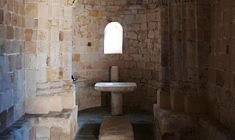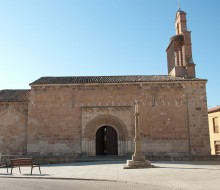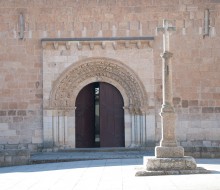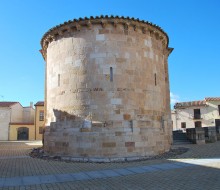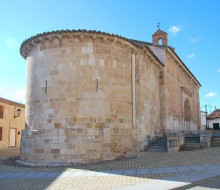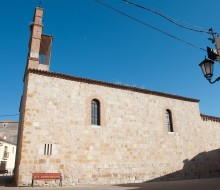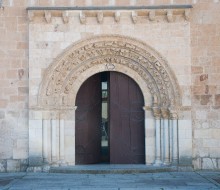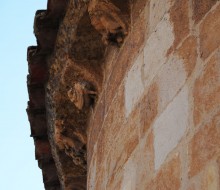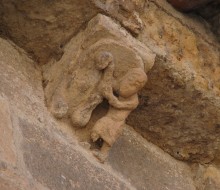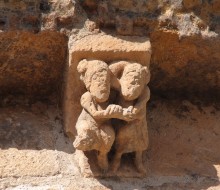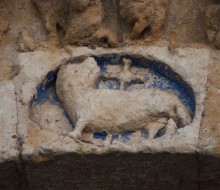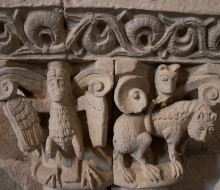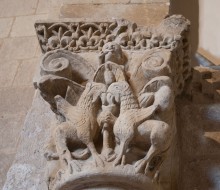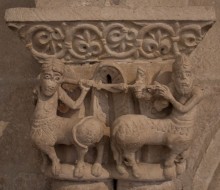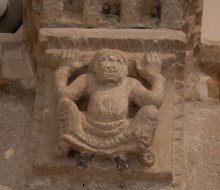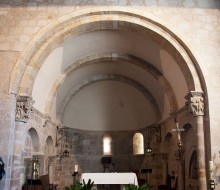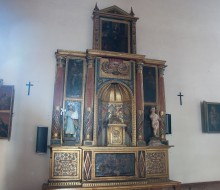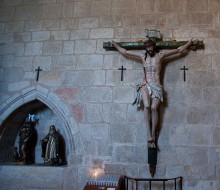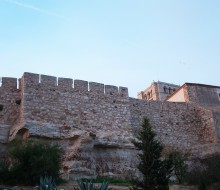Church of San Claudio de Olivares
Zamora
Church of San Claudio de Olivares
Zamora12th century
Built in the early 12th century, specifically in 1176, it was the heart of the neighborhood of Olivares. It offers a rich sculptural decoration both in the archivolt of the portico and in the capitals of the inner columns. It must have been built in two phases: the apse during the middle of the century and the rest, at the end of it. It is considered the oldest Romanesque church in Zamora. Here you can find the sculpture called “Cristo del Amparo”.
It is a small-sized church consisting of a single irregular nave with straight-section chancel and extreme-semi-circular apse. The front has been opened in the southern wall and it extends over the gable ending in a belfry with a bell-hole. Initially it was vaulted, but being its southern wall near the Douro River, its floods reached its lower part, which was finally replaced by a wooden frame. This wall, as well as the foot one, has been rebuilt and reinforced several times. The cover that was in it was removed too.
The apse, which has a semicircular floor plan, stands on a podium which steps are divided into five sections by six pedestals upon which should have been erected many small columns attached to the smooth facing. Among these columns the one located at the southern extreme of the drum has been preserved. The opposite column has been added during the recent restoration. The cornice of the apse is decorated with a checkered band and has a magnificent collection of human-motif corbels.
The doorway is opened on the northern wall on a poorly marked projection which is covered by a cornice supported by ten corbels. It has a semi-circular arch with four decorated archivolts. The inner arch has no decoration except for the keystone, and rest on the doorjamb and the other three arches full of decorative figures do it on bent columns. The capitals that still remain are badly damaged, but vegetable decoration can be guessed. The surrounding frame of the doorway is decorated with a succession of alternating-size canes.
Inside, the nave is covered nowadays with gable-roof made-of-wooden frames. Originally it had a barrel vault that was useless because of the instability of supporting walls, mainly the southern one which is closest to banks of the Douro River. It is clear the movement of the southern wall of the chancel which has created an uncorrected escarpment, but neutralized by the front wall that acts as a buttress and has a sharply trapezoidal plane.
The chancel is of considerable length. That is why it is organized in two sections defined by the triumphal arch at the entrance, a central semi-circular arch on consoles and another at the beginning of the apse hemicycle that rest on the protruding part of the wall.
The capitals of the triumphal arch, as well as the rest of blind arcades, are of great sculptural value and have been preserved impeccably. Here is venerated the “Cristo del Amparo”. This anonymous image of the 17th century is carried through the streets in procession by the “Hermandad de Penitencia” (Brotherhood of Penitence) that takes place on Holy Wednesday. Equally interesting is the Baroque altarpiece of the chapel of the Fermoselle family.
It is famous because the “Capas Pardas” (Brownish-gray Capes) procession starts leaving this church every Holy Wednesday at 12 am and since 1931, this church is a national historic-artistic monument.
Exterior de la Iglesia de San Claudio de Olivares
El ábside, elevado sobre un podio corrido que viene dividido en cinco tramos, es de trazado en hemiciclo y se eleva por seis pedestales con otras tantas columnillas. De esas sólo se conserva la del extremo sur del tambor. La cornisa del ábside se adorna frontalmente con una banda ajedrezada y posee una colección de magníficos canecillos figurativos.
Se abre la portada en el muro norte sobre un arimez poco marcado cubierto por cornisa que soportan diez canecillos. Es de arco de medio punto con cuádruple arquivolta y chambrana. La rosca interior, lisa salvo en la clave, se apoya sobre las jambas de la puerta; las otras tres, cuajadas sus dovelas de figuras decorativas, lo hacen sobre columnas acodilladas. La chambrana que circunda la portada se adorna con una sucesión de palmetas de tamaño alternante.
Interior de la Iglesia de San Claudio Olivares
En el interior, la nave se cubre hoy con armaduras de madera a doble vertiente. En origen lo hacía con bóveda de cañón que sucumbió ante la inestabilidad de los muros sustentantes, principalmente del meridional próximo al cauce del Duero.
Es patente el giro hacia el exterior del muro sur del presbiterio que ha producido una escarpa no corregida pero sí neutralizada por el muro frontal que actúa de contrafuerte y que presenta una plano de forma acusadamente trapezoidal. El presbiterio es de una notable longitud, por lo que se encuentra organizado en dos tramos definidos por el arco triunfal en la embocadura, un fajón de medio punto en el centro descargando sobre ménsulas y otro en el plano de inicio del hemiciclo absidal que se apoya sobre el recrecido del muro. Los capiteles del arco triunfal, al igual que los restantes de las arquerías ciegas, son de un gran valor escultórico y se han conservado de forma impecable.
En el interior se venera la imagen del Cristo del Amparo, anónimo y del siglo XVII, cuya procesión a cargo de la Hermandad de Penitencia se realiza el Miércoles Santo. Igualmente interesante es el retablo barroco de la capilla de los Fermoselle.
GET DIRECTIONS
ROUTES
OPENING HOURS AND VISITS
From 1st October until 6th January:
Friday and Saturday: from 10:00 to 14:00 and from 16:30 to 18:30.
Sunday: from 10:00 to 14:00.
From 5th March until 30th September:
From Monday to Sunday: from 10:00 to 13:00 and from 17:00 to 20:00.
Closed on Monday.
GENERAL INTEREST SERVICES
Tourist offices:
- Local tourist office: It is located at 5, Arias Gonzalo Square. Tel. +34 980 533 694
- Castilla y León tourist office: It is located at 1, Príncipe de Asturias Avenue. Tel. +34 980 531 845
- Provincial tourist office: It is located at Viriato Square. Tel. +34 980 534 047
Local police: Tel. +34 980 531 245
Civil Guard (police with responsibilities outside towns): Tel. +34 980 521 100
Emergency telephone numbers: 112
- Virgen de la Concha (Hospital): Tel. +34 980 548 212
Bus station: Tel. +34 980 521 281
Train station: Tel. +34 980 521 110
Taxi: Tel. +34 630 630 630
Civil defence: Tel. +34 980 536 190
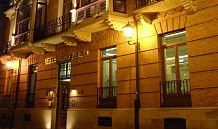
Hotel Horus
Zamora
El Hotel Horus, abierto en el año 2001, tiene un total de treinta y ocho habitaciones dobles que se dividen entre cuatro…
More info